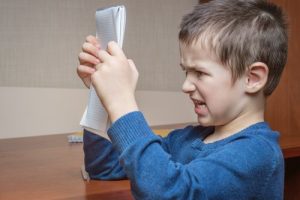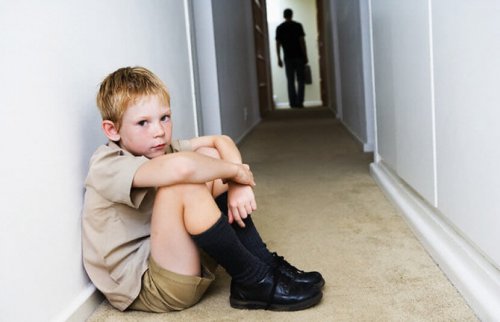How to Prevent Anxiety in Children

Both adults and children can suffer from anxiety. In this article, we’ll provide tips on how to prevent anxiety in children through some very simple techniques.
Anxiety has various consequences. It can affect children’s physical and mental well-being. It can also affect their relationship with their environment.
Anxiety is a defense mechanism in the face of a threat or danger. As an adaptive function to the environment, anxiety is both good and normal.
However, anxiety becomes a problem when it happens frequently and without a reason. This can happen when children feel afraid, or concerned about things they don’t need to be.
There are several factors that can lead a person to suffer from anxiety, such as biological traits, personality, and environment.
How does anxiety appear in children?
Children who suffer from anxiety experience the following symptoms:
- Intense fear
- Concern
- Irritability
- Restlessness
- Nervousness
It also causes physical signs in people. Of course, children are no exception. An anxious child may show the following symptoms:
- Fainting
- Rapid heartbeat
- Fever
- Cold, clammy hands
- Headaches or stomach aches
- Insomnia and even seizures
What situations can cause anxiety in children?
If you want to know how to prevent anxiety in children, it’s important to know why it can appear. As we said before, there are three types of factors that predispose someone to suffer from anxiety.
You can’t do anything about the biological factors, as they’re embedded deep in the mind and genetics of the child. Regarding personality factors, you can teach your child problem-solving techniques. You can also help change their lifestyle to live an all-around better life.
When it comes to the third factor, environment, you can make the biggest difference. Pay close attention to how he acts in his social circles (school, sports classes and the family) and what causes him to feel anxious.
The child’s closest adults, like parents and teachers, play an important role in the mission to reduce childhood anxiety.
How to prevent anxiety in children
These recommendations can be effective if you’re looking to prevent anxiety in children. Remember that it’s very important to figure out the cause to know how to move forward with treatment.
- Talk to him. Ask him what worries him, why, and how he feels about it. You need to be available so he can vent to you. Don’t harass him or force him to tell you what he doesn’t want to.
- Be a good example. Always behave reasonably and think about your actions without panicking. Then, little by little, your child will mimic this behavior and learn that everything has a solution.
- Teach him to face his problems. You can use the metaphor of a snowball: the more you let it roll, the bigger it gets. This way, he’ll know that problems arise so that you can overcome them and better yourself.

- Don’t downplay your concerns. If you look at everything through the eyes of an adult, the problems will seem minor. You won’t understand the reason for your child’s anxiety.
- You need to avoid thinking this way. Things that might seem small to you could actually be very challenging for your child.
- Be understanding. If a child feels alone when faced with an uncomfortable situation, his anxiety will increase. If, on the contrary, you show affection and support, he’ll feel more confident to face problems.
“Always behave reasonably and think about your actions without panicking. Then, little by little, your child will mimic this behavior and learn that everything has a solution.”
- Congratulate children for their achievements. A lot of anxiety is cased by believing you can’t face a problem or a challenge.
- If you make children aware of their capabilities, their mindset will change. They will start to face everything in a more positive way.
- Let children have fun. Micromanaging your children can wreak havoc on their personality. On the contrary, if you allow them to have fun and relax every day, there’s less space for worries in their head.
Conclusion
As a final tip, it’s important to get involved in your children’s life. Without pressuring them or invading their privacy, it’s good to know what happens to them on a daily basis.
This way, you can find a possible conflict in advance to help your children face it. While there is no magic recipe that teaches us how to prevent anxiety in children, you can work on their attitudes to solve problems.
All cited sources were thoroughly reviewed by our team to ensure their quality, reliability, currency, and validity. The bibliography of this article was considered reliable and of academic or scientific accuracy.
- Bragado, C., Bersabé, R., & Carrasco, I. (1999). Factores de riesgo para los trastornos conductuales, de ansiedad, depresivos y de eliminación en niños y adolescentes. Psicothema, 11(4). https://www.redalyc.org/html/727/72711415/
- Cárdenas, E. M., Feria, M., Palacios, L., & de la Peña, F. (2010). Guía clínica para los trastornos de ansiedad en niños y adolescentes. México: Instituto Nacional de Psiquiatria Ramón de la Fuente Muñiz.
- Reynolds, C. R., & Richmond, B. O. (1997). Escala de ansiedad manifiesta en niños (revisada). El Manual Moderno.
This text is provided for informational purposes only and does not replace consultation with a professional. If in doubt, consult your specialist.
